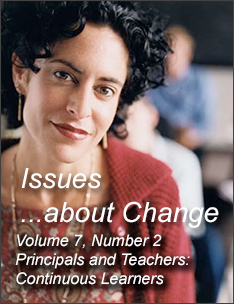Concluding Thoughts
In her work on effective leadership and school change and improvement, Hord (1997) points out that "as an organizational arrangement, the professional learning community is seen as a powerful staff development approach and a potent strategy for school change and improvement." (p.1) The principal must be willing to establish a context that nurtures the development of a PLC. Fortunately, some of the principals who have created this context have begun to write about their understanding of it. When Brian Riedlinger, an elementary school principal decided to develop a professional learning community among his staff, he soon realized that he would have to model the practices he wanted from his teachers. "Although I sensed my final objective, getting to that objective would be my struggle. I suspected that intensive staff development would be the driving force, but my question became, 'what would I need to do to change myself that would lead teachers in the same direction I was moving?' " (Riedlinger, 1998, p.5).
Another successful elementary school principal, Flo Hill writes with two university colleagues:
"No longer are school administrators expected to be merely managers of routines, but must prepare to take initiative. In collaborative school climates, the principal must understand change as well as manage it. Openness to diversity, conflict, reflection and mistakes becomes a necessity. In the facilitative role of fostering collaboration and collegiality, the principal must motivate staff to be dynamically interactive, professionally effective and mission oriented. Thus, knowledge of professional and organizational development and strong interpersonal and communication skills are critical components." (Hill, Lofton and Chauvin, 1995 pp.1-2).
In order to address these increasingly complex responsibilities, some principals have created communities of staff learners. These principals use their leadership role to demonstrate and encourage continuous learning for themselves and all staff members in order to increase the effectiveness of their schools.
Next Page: References, Credits, and Disclaimer

